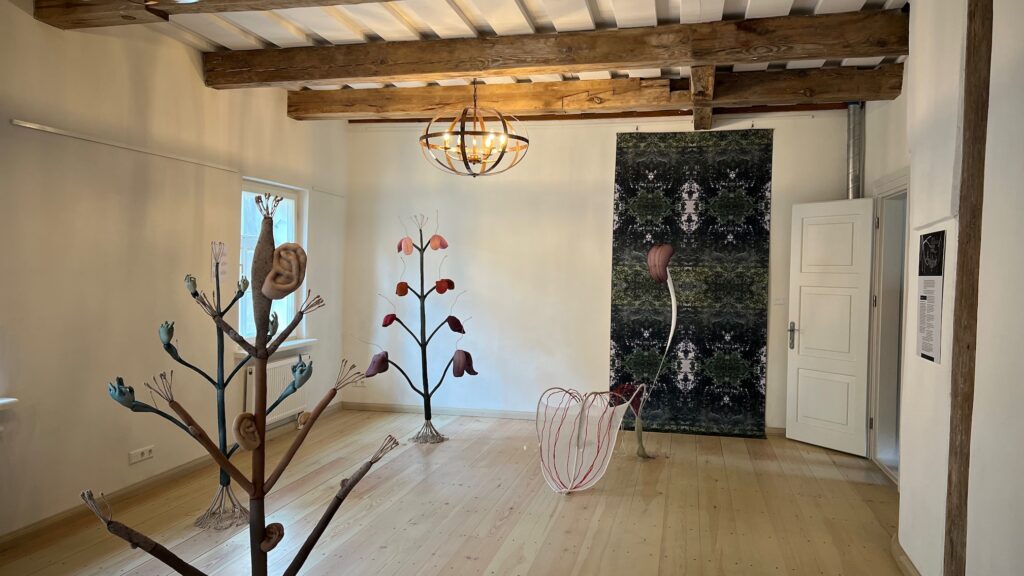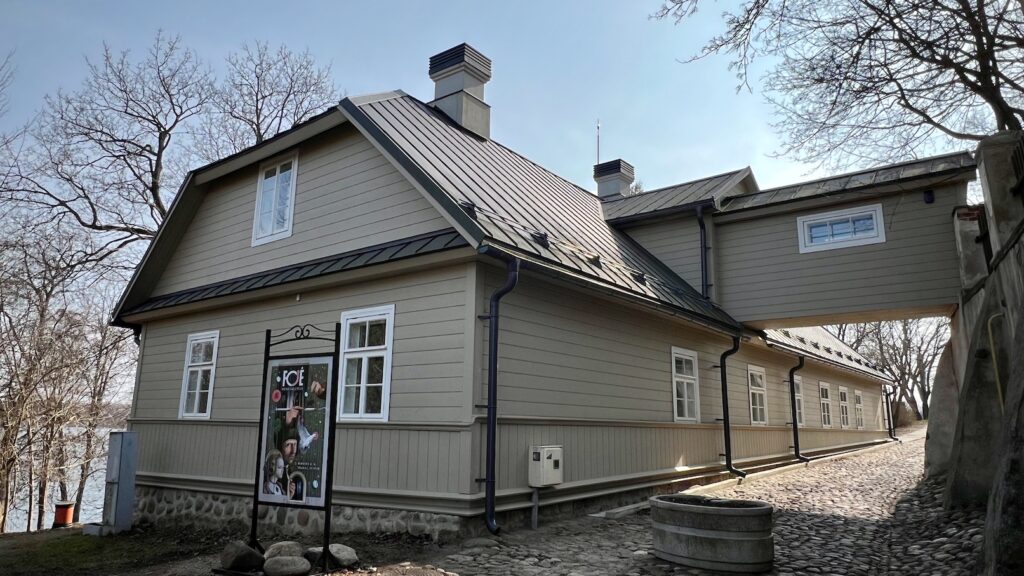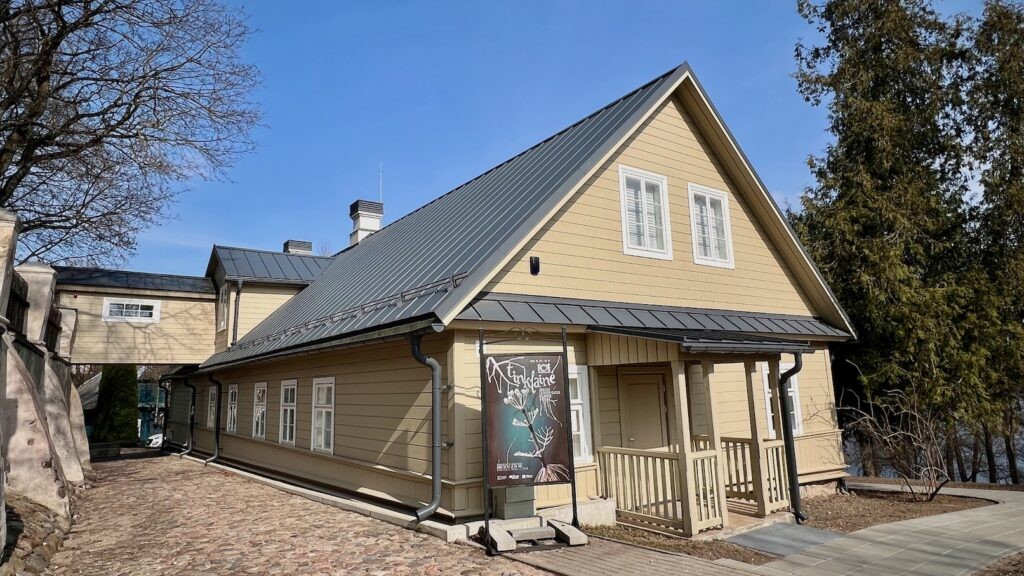Few months ago Trakai was enriched with a new cultural space - the Fojë art gallery opened its doors in the former old rectory. According to the specialists of the Cultural Infrastructure Center (KIC) who organized the maintenance work, it is always nice to know that a building brought to new life will not be forgotten again, that it will become a place for events and gathering of people.
St. Trakai The project for maintenance (repair, conservation, restoration) of the parsonage building of the Church of the Visitation of the Virgin Mary was started in 2018 by order of KIC. The works were completed at the end of 2023, and the Edita Tamulytė art gallery "Fojė" was located in the immediately revived building. Now, the works of the artist Jūratė Kazakevičiūtė's object exhibition "Tinklainė" organized here organically fit into the environment of the new gallery, without overshadowing the specially left masonry and ornament fragments of the wall of the old building.
On the day we visited, there was no shortage of visitors in the gallery - some came to see the exhibition, a group of worshipers gathered in the attic of the second floor. Life was boiling throughout the building, from the ancient basement to the rooms on the second floor.
A completely different sight would have greeted you a few years ago, if only you had been willing to enter here. On the first floor, just after entering the gallery, visitors can see photos of how the rectory looked like before the maintenance work began, and get to know its history, which was written by Antanas Ulčinas based on Dainius Labeckis's research of the Trakai rectory building. We will use this information further.
200 years of history
According to historical research, the rectory was built in the 1805th century. at the beginning, in 1820. It was a two-story building built of logs on a masonry foundation, a four-room basement was built (bricks from Trakai Castle were used), and the roof was covered with shingles. In the visitation documents of 1821-34, it is detailed that the rectory's residential house is 15,5 cubits long, 10 wide and XNUMX high, and stands along the street, which has long been called Klebon street.
It is not known what the quality and materials of the construction works were at that time, but already in 1826, the dean of Trakai, priest Andrius Čerskis, tried to draw the attention of his superiors to the poor condition of the rectory. In 1855, the pastor of Trakai, priest Ludvigas Zdanovičius, already explained in a letter to the bishop that the rectory building was "completely collapsed". The bishop heard the complaints, and already the following year, the building was substantially repaired. A few years later, the parsonage building was reconstructed from a two-story to a single-story, and even later - in 1890, at the expense of priest J. Karvovskis, a corridor across the street to the churchyard was newly built, the roof was covered with shingles, and interior finishing works were carried out. Another serious repair was waiting for the rectory building in 1924.
After the Second World War, the rectory building was taken over by Raikomchoz, families were moved here (in 1981, 19 people lived). Seven apartments were installed for the new residents, as a result of which the interior layout of the building had to be rearranged.
The parish of Trakai regained the building that once belonged to it in 2011, and then historical research was carried out. Later, the search for funds for the restoration of the building began. Management works started in 2018 will be completed in 2023.
The dilapidated building has regained its former appearance
Before starting the management work, detailed studies of the immovable cultural heritage object were carried out. During them, it was found that the condition of the foundations supporting the log walls, the overlay and the roof structures is unsatisfactory, that is, the ground part of the foundation is decayed, part of the walls, as well as the beams of the overlay are rotten, the overlay has lost its bearing capacity, the ends of the roof rafters, and in some places all the rafters are damaged rot.
"The building was significantly affected by time, its original appearance was significantly changed by the repairs and reconstructions carried out during the Soviet era: windows, doors were changed, furnaces and chimneys were rebuilt. During the maintenance work, it was aimed not to damage the remaining valuable features of the building, to preserve them as much as possible, to restore them, and to restore the decayed valuable elements according to the data of the conducted research", commented Daina Vanagaitė–Garbanovienė, the design manager of the KIC Design Supervision Service.
In the rectory building, the foundations of stone and brick masonry were restored, the masonry of the basement rooms was restored, the wooden ceilings, the wooden roof structure were repaired, the former first floor plan structure was restored, and a new roof covering was installed. The two-story extension of the eastern facade was also restored; the porch of the southern facade, the facades are covered with wooden paneling. The wooden stairs to the attic were restored according to the data of nature; restored interior wall plaster and fragments of decorative wall paintings; preserved fragments of carved found walls; window and door openings, carpentry and their edges have been restored according to research; reclaimed wood floors and ceiling paneling.
The bridge leading from the parsonage to the church yard was rebuilt in the place determined by the research. Maintenance works for heritage conservation are part of the works carried out in the vicarage, thanks to which the old vicarage has regained its former appearance.
The customer of maintenance works is the Cultural Infrastructure Center. The works were financed by the Republic of Lithuania the Ministry of Culture Funded by the Heritage Program.
In a separate project, parallel to these, the Archdiocese of Vilnius organized maintenance construction works so that the building would be adapted for future life.




